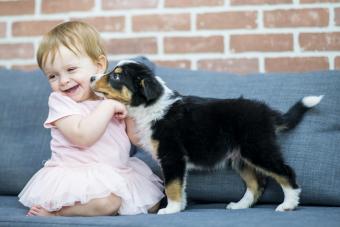
Bringing home a new baby leads to all sorts of life changes for you and your family. This includes your canine family too, especially if you also have a young puppy in the house. Babies and puppies can coexist if you plan ahead and set up their interactions safely and positively.
After Baby Is Home
No matter how much you prepare your puppy for the baby, his world will change drastically once the infant is home. There will be new sounds, smells, sights and the level of interaction with his humans will change. Katenna Jones, ACAAB, of Jones Animal Behavior in Rhode Island, teaches her new mother clients to observe some rules to make the process a smooth one.
Baby Wraps and Blankets
If you can get it from the hospital, bring home the baby wrap and put it on the fake baby so the puppy is used to the scent. Once the baby has its first bath, take the baby's cap and let the puppy sniff it and pair this with praise and treats. You can also take a baby blanket your infant has slept in and put it in your dog's crate or on his bed.
Outlets for Puppy
Give the puppy lots of opportunities such as new toys, food-stuffed toys, chews, and daily walks. If you're able to hire a dog walker or have someone take him to doggie daycare, this can help as well. You should also create a "child-free" space for the puppy, as well as one for the baby. This each gives them a safe place to play and move about and gives them time to not feel overwhelmed with each other.
Always Supervise
Always supervise interactions between the puppy and baby. Start these out slowly and first introduce the baby to the puppy by placing the puppy behind a baby gate. Keep these sessions short and make them positive for the puppy and gradually practice sits, downs. and stays with the puppy while tossing him treats for the behaviors.
Allow Interaction
When you feel comfortable, allow the puppy more movement around the baby but remember to observe your puppy's body language to ask him to sit or lie down if you sense he's going to jump on the baby to play. Gently guide your baby's hand to touch the puppy while asking your puppy to stay. Once your infant is old enough, you can have him sit on your lap and help him to toss a toy to the puppy and play fetch.

The Crawling Stage
When your baby starts crawling, this may scare your puppy, so carefully supervise them, either with baby gates or another person keeping puppy on a leash or a drag line. Pair this with great things for the puppy until he's used to this movement.
Problem Behaviors
If your training hasn't worked out as well as you hoped, and your puppy is still jumping and has trouble holding stays, consider having a trainer come to your home and help you with this.
If you observe your puppy growling at the baby, Jones advises to "never punish him for growling. This indicates he is stressed, confused or fearful." In these cases, she recommends contacting a behavior professional to help you right away, and make sure the baby and puppy do not get close to each other in the meantime.
Babies and Puppies Together
If you plan your pre-birth and after-birth preparations well and are diligent about practicing, you will be own your way to a successful baby and puppy relationship. Download the Pet Meets Baby guide from the American Humane Association as preliminary reading. Jones strongly suggests starting early, and states: "Don't wait to get started as soon as you can, and if you feel you need help, don't hesitate to call a professional to assist you." Through patience and practice, and outside help if needed, puppy and the new baby can get along in the home.







